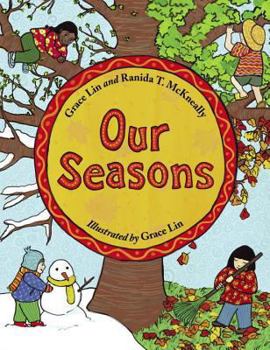Our Seasons
Select Format
Select Condition 
Book Overview
What's your favorite season? Gentle haikus and informative panels guide four friends on a journey through winter, spring, summer, and fall. Follow Ki-ki, Owen, Lily, and Kevin through the year as they... This description may be from another edition of this product.
Format:Hardcover
Language:English
ISBN:1570913609
ISBN13:9781570913600
Release Date:June 2006
Publisher:Charlesbridge Publishing
Length:32 Pages
Weight:1.01 lbs.
Dimensions:0.4" x 8.7" x 11.3"
Age Range:5 to 8 years
Grade Range:Preschool to Grade 3
Customer Reviews
2 ratings
Great Introduction to Science for Young Readers
Published by Thriftbooks.com User , 14 years ago
Our Seasons is an excellent science book for children because it answers questions simply and completely, but it does not "dumb down" answers or "talk down" to its audience. This book is not afraid to use science-appropriate words like "revolves around" (instead of, say, "moves around") and "structures" (instead of, say, "parts"). While reading this book to my 4-year-old daughter, she frequently stopped me to ask me what a word means. I thought the exercise in building vocabulary was great, and she wanted to re-read the book as soon as we finished it the first time. For some of the words most likely to be unfamiliar to a young child, there is a short glossary on the last page that defines words like "abdomen", "condensation", and "pigment". With a book that may be full of unfamiliar words, a parent might wonder how the book can keep the young reader engaged. One reason, I believe, is the book's presentation. Every question and answer is provided on a two-page spread with full-page illustrations in vibrant colors - all in Grace Lin's signature style. Also, a lovely haiku accompanies each question/answer. The book includes answers to common questions like "Why do we have seasons?", "Why do leaves change color?", and "What is snow?", but it also addresses interesting, less commonly seen questions related to seasons, such as, "Why do my cheeks turn red in the cold?", "Why do I sneeze [in the springtime]?" (The answer to this question taught me something new!), and "Why do I tan [in the summertime]?" The recommended age range for this book is 4-8, though it might be most appropriate for school-aged children. I think my 4-year-old daughter is JUST at an age that she can begin to appreciate the factual aspects of the book. I look forward to re-reading this book to her in the years to come; I think she will grow into it more in maybe a year or two.
Science Q & A plus haiku
Published by Thriftbooks.com User , 15 years ago
In this unusual picture book arts and science come together in one intriguing presentation. Cheerful haiku and richly colored paintings interact with serious questions and answers about weather, seasons, and their effect on the human body. The first question, "Why do we have seasons?" sets up a simple explanation of how the earth tilts on its axis. From this broad beginning, the text zeroes in on familiar yet interesting questions ranging from "What makes the wind?" to "Why do I tan?" Within each seasonal section, movement from the natural world to the child's own experience is logical. For example, the question "Why do I see my breath?" follows "Why is there frost on the window?" Both answers involve water vapor. Asking "Why do bees like flowers?" leads to "Why do I sneeze?" No surprisingly, these answers mention pollen. The accompanying haiku feature four friends, Ki-Ki, Owen, Lily, and Kevin, who further personalize the science. The prose answer to "Why do my cheeks turn red in the cold?" explains about blood vessels and warmth, while the haiku on the facing page offers the more imaginative theory that "Owen's cheeks turn red / From the cold lipstick kisses / Given by the wind." This contrast provides much to enjoy and ponder. Lin's luminous gouache paintings fill three-quarters of each spread; that is, a full page plus half of the facing page for each illustration. The effect is that readers are pulled into the warm and colorful scenes. Especially lovely is a vivid garden in which Lily, in matching flowered hat, caresses the flowers. Occasionally, oversimplification causes a loss of clarity. The page on "Why do leaves change color?" contains the circular definition, "The color of leaves depends on what kind of pigment they have in their cells. Pigments are tiny spots of color." In other words, the color of leaves depends on their color--which is true but not particularly enlightening. Fortunately, explanations are more often right on target for young readers. From the close-up specifics within the four seasonal sections, the final text returns to a broader view. The query "Does everyone have four seasons?" launches a simple explanation about how being at the equator or at one of the poles causes different seasons (wet and dry or light and dark, respectively), reminding readers of the earth's tilting axis from the introduction. Preschool and primary kids, busy learning about the world we live in, are usually fascinated by science and nature. Our Seasons offers artistic, poetic, and scientific approaches to our world in one enticing package.






